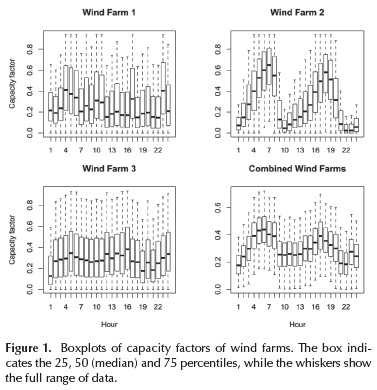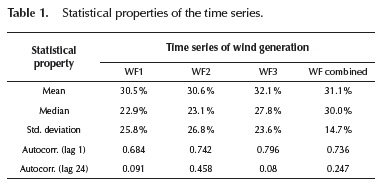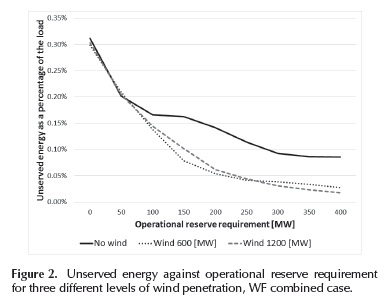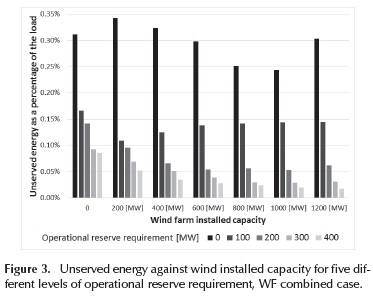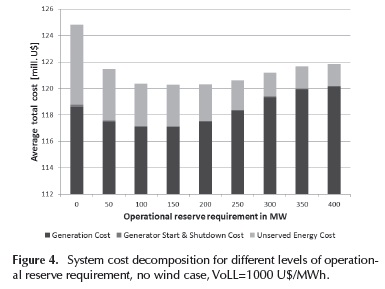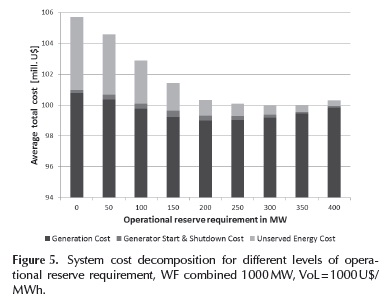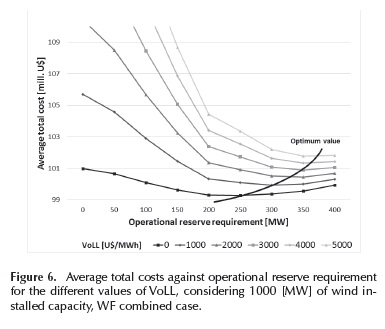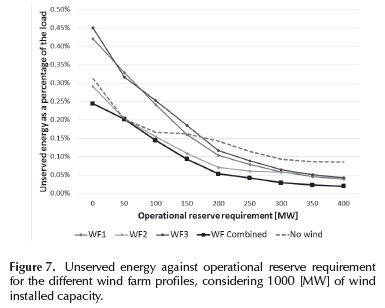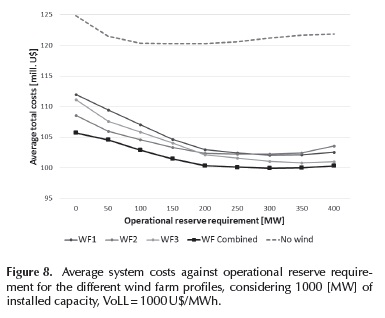Services on Demand
Journal
Article
Indicators
-
 Cited by SciELO
Cited by SciELO -
 Access statistics
Access statistics
Related links
-
 Cited by Google
Cited by Google -
 Similars in
SciELO
Similars in
SciELO -
 Similars in Google
Similars in Google
Share
Ingeniería e Investigación
Print version ISSN 0120-5609
Ing. Investig. vol.35 supl.1 Bogotá Dec. 2015
https://doi.org/10.15446/ing.investig.v35n1Sup.53698
DOI: http://dx.doi.org/10.15446/ing.investig.v35n1Sup.53698
Power system reliability impacts of wind generation and operational reserve requirements
Evaluación de impactos en la confiabilidad de sistemas eléctricos de potencia para distintos niveles de penetración de energía eólica y requerimientos de reservas operacionales
E. Gil1
1 Esteban Gil: PhD in Electrical Engineering and MSc in Statistics, Iowa State University, USA. BSc and MSc in Electrical Engineering, Universidad Técnica Federico Santa María, Chile. Affiliation: Universidad Técnica Federico Santa María, Chile.
E-mail: esteban.gil@usm.cl
How to cite: Gil, E. (2015). Power system reliability impacts of wind generation and operational reserve requirements. Ingeniería e Investigación, 35(sup1), 82-88. DOI: http://dx.doi.org/10.15446/ing.investig.v35n1Sup.53698
ABSTRACT
Due to its variability, wind generation integration presents a significant challenge to power system operators in order to maintain adequate reliability levels while ensuring least cost operation. This paper explores the trade-off between the benefits associated to a higher wind penetration and the additional operational reserve requirements that they impose. Such exploration is valued in terms of its effect on power system reliability, measured as an amount of unserved energy. The paper also focuses on how changing the Value of Lost Load (VoLL) can be used to attain different reliability targets, and how wind power penetration and the diversity of the wind energy resource will impact quality of supply (in terms of instances of unserved energy). The evaluation of different penetrations of wind power generation, different wind speed profiles, wind resource diversity, and different operational reserve requirements, is conducted on the Chilean Northern Interconnected System (SING) using statistical modeling of wind speed time series and computer simulation through a 24-hour ahead unit commitment algorithm and a Monte Carlo simulation scheme. Results for the SING suggest that while wind generation can significantly reduce generation costs, it can also imply higher security costs to reach acceptable reliability levels.
Keywords: Wind power, uncertainty modeling, variable generation, reserve requirements, value of lost load.
RESUMEN
Debido a su variabilidad, la integración de generación eólica presenta desafíos significativos para los operadores de los sistemas eléctricos a la hora de mantener niveles de confiabilidad adecuados asegurando, de forma simultánea, una operación a mínimo costo. Este artículo explora los beneficios asociados a una mayor penetración de generación eólica y los requerimientos adicionales de reservas operacionales que esta impone. Dicha exploración se realiza en términos de los efectos de la energía eólica en la confiabilidad del sistema, medida como cantidad de energía no servida. El artículo, además, se enfoca en cómo es que al cambiar el costo de falla se puede motivar el alcance de diferentes metas de confiabilidad, y cómo la penetración y diversidad del recurso eólico impactan la calidad de servicio (en términos de instancias de energía no servida). La evaluación de diferentes niveles de penetración, diferentes perfiles de velocidad de viento, diversidad del recurso eólico y distintos requerimientos de reservas operacionales, se lleva a cabo en el Sistema Interconectado del Norte Grande (SING) chileno usando modelos estadísticos de velocidad de viento y simulación computacional mediante un algoritmo de pre-despacho y un esquema de Monte Carlo. Los resultados para el SING sugieren que mientras la generación eólica puede reducir significativamente los costos de generación del sistema, también implica mayores costos de seguridad para alcanzar niveles de confiabilidad adecuados.
Palabras clave: Energía eólica, incertidumbre, generación variable, requerimientos de reserva, costo de falla.
Received: September 10th 2015 Accepted: October 1st 2015
Introduction
During the last decade, wind generation technology has been maturing and becoming more competitive against conventional generation technologies. As wind power generation's prominence in the electric energy supply increases, power system operators and regulatory bodies need to be prepared not only for its promised benefits but also for novel operational and regulatory challenges. For instance, the variability of the wind energy resource and the non-dispatchable nature of its generation may erode the reliability of the energy supply, deteriorating its quality if both preventive and corrective measures are not taken by system operators.
Power system reliability is usually defined in terms of two dimensions: adequacy and security. While adequacy refers to the capacity of generation to meet the system demand taking into account unexpected outages of generators or transmission lines and possible constraints on the primary energy resource (e.g. problems on the fossil fuel chain of supply, lack of wind), security refers to the system's capacity of reaction and recovery to endure short term contingencies (NERC, 2012; Billinton & Allan, 1996). When new wind generation capacity is added to a power system, its adequacy tends to increase as a result of the extra generation, and system fuel costs tend to decrease as thermal generation is displaced due to the nearly nil variable generation costs of wind. However, system security may potentially deteriorate if the systems operators do not take preventive and corrective measures to deal with the extra uncertainty brought by wind variability. These measures usually take the form of ancillary services, carrying additional operational costs to the system. Thus, while the fuel costs tend to decrease with higher wind penetration, ancillary services costs tend to increase in order to maintain system security and a satisfactory quality of supply.
If wind generation is overestimated when scheduling generating units, a shortage of baseload thermal generators could occur, potentially causing power outages and increasing operating costs. If underestimated, wind energy could be spilled. Consequently, wind uncertainty could have a significant impact on power system operations in terms of costs and reliability. Of course, that impact will be higher as wind penetration grows. Independent System Operators (ISO) can take different general approaches to accommodate the additional uncertainty at the unit commitment level, such as improving forecasting models for the wind (Mahoney et al., 2012), adjusting reserve requirements for the system (NERC, 2010; Ortega-Vazquez & Kirschen, 2009; Wang & Hedman, 2015; Luna-Ramírez, Torres-Sánchez, & Pavas-Martínez, 2015), implementing stochastic unit commitment (Ruiz, Philbrick, Zak, Cheung, & Sauer, 2009; Papavasiliou, Oren, & O'Neill, 2011; Holttinen et al., 2012), and/or using a rolling-planning scheme (Tuohy, Meibom, Denny, & O'Malley, 2009). Thus, among the ancillary services needing revision as wind prominence grows are operational reserves, that is, the extra generation capacity put online in the day-ahead unit commitment. This spare generation capacity compensates for possible errors on load and/or wind forecast and for eventual outages in generators and transmission lines. It also adds more flexibility to the system operation in case sudden mismatches in the supply/demand balance occur.
This paper explores the trade-off between the benefits associated to a higher wind penetration and the additional operational reserve requirements that they impose. Such exploration is valued in terms of wind generation effects on power system reliability, measured as hours and amount of unserved energy, which are obtained in a Monte Carlo simulation scheme. The paper also focuses on how changing the Value of Lost Load (VoLL) set for the system can impact on the optimum reserve requirement levels. The impact of the diversity of the wind resource is also explored. All simulations are conducted using a computational model of the Chilean Northern Interconnected System (SING).
This paper is structured as follows: Section II discusses the wind modeling and simulation methodology; Section III describes the test system (SING) and the wind data utilized in this study; Section IV presents and discusses simulation results with an emphasis on the reliability impacts of wind generation variability and diversity for different levels of operational reserves. Finally, Section V summarizes the main conclusions of the paper.
Methodology
The methodology employed in this paper can be separated in three stages. First, a Seasonal Auto-Regressive Moving Average (SARIMA) model (Lange & Focken, 2006) is fitted to the wind speed data in order to generate wind speed forecasts and synthetic wind speed profiles for their latter use in a Monte Carlo evaluation scheme. These wind speed profiles are then converted to wind power using standard wind turbine power curves, and then corrected to simulate the wind farm effect. Second, using the wind generation forecasts obtained in the first step, a set of 24-hour ahead unit commitment (UC) decisions are made for different levels of wind penetration and operational reserve requirements. These UC decisions are made using a commercial energy market software. Third, each of the UC sets of decisions obtained in the second step will be fed into a Monte Carlo scheme that will solve the economic load dispatch considering randomly sampled wind generation synthetic profiles and generator and transmission line outage patterns. Each of these three stages is explained in further detail in the rest of this section.
First stage: Wind modelling
Different types of statistical models can be found in scientific literature that represent wind speed data. For instance, the Weibull distribution is frequently used when characterizing the probability distribution of the wind speed. However, when interested on forecasting and/or generating synthetic wind speed patterns, other models capable of representing the autocorrelation function of the time series are preferred. In this paper, Box Jenkins time series models are used, particularly a SARIMA model that is adjusted to historical hourly wind speed data series measured at 3 different locations in Chile. This SARIMA model is used for two purposes. First, to forecast wind generation for the next unit commitment scheduling period. Second, to create wind generation scenarios for an a posteriori evaluation of UC decisions.
There is a clear seasonal daily pattern in some of the wind profiles (see Figure 1), so an adaptive SARIMA model with a 24-hour seasonal component was adjusted to the data. The SARIMA model is adaptive as the parameters of the model are re-estimated daily, so that the model can also follow slower dynamics present in the time series data (e.g. seasons). Different SARIMA models were tested, and the order of the model was chosen to be (1,0,1)x(1,1,1)24 so as to minimize the Akaike Information Criterion (AIC), a statistical metric of the goodness of fit penalized according to the complexity of the model (number of adjusted parameters) (Akaike, 1998). Additionally, an analysis of the residuals (actual minus fitted values) closely resembled white noise, and a comparison of the statistical properties (moments, auto-correlation function, and partial auto correlation function) of the actual data versus simulated data showed a good fit.
The SARIMA model was used for two purposes: First, to daily forecast wind generation for the next day, in order to use it in the UC stage to decide the next day online baseload thermal units. This was done by creating new values for the SARIMA stochastic process while setting the innovations to zero. Second, to generate synthetic wind generation profiles to use in the Monte Carlo simulation scheme. This was performed by creating new values for the SARIMA stochastic process while randomly sampling values from the equivalent normal distribution of the residuals and replacing them in the innovations. This procedure is similar to the one used in Gil & Aravena (2014) and Wetzel & Gil (2014). The procedure was programmed and executed in the statistical programming language R (R team, 2012).
Second stage: Unit commitment decisions
Using the load and wind generation forecasted profiles for the next day, the baseload thermal generators are scheduled to operate or not, that is, a day-ahead unit commitment (UC) problem is solved for the system. As the load for the test system is mainly mining and industrial and not weather-dependent, its profile is relatively flat, so load can be forecasted using a simple persistence model adjusted to the day of the week. The UC considers a hard operating reserve requirement to account for unexpected outages and errors in the load and wind forecasts. Most on-off decisions of large baseload generators need to be modeled as integers and the unit commitment becomes a relatively large Mixed Linear Integer Program (MILP) to solve. The optimization problem is similar to the one in Carrión & Arroyo (2006) and includes thermal generators' loading ramps, minimum up and down times, and start/shut down costs.
The mathematical program is formulated by PLEXOS (Energy Exemplar, 2015), a commercial electricity market simulation software widely used in renewable energy integration studies (e.g. NERC, 2012; Daly, Power, Keane, & Flynn, 2013; Lannoye, Flynn, & O'Malley, 2012). PLEXOS is currently used by the SING's ISO to conduct 4-day-ahead UC, 1 day-ahead UC, and redispatch. The MILP is later solved by the optimization solver XPress (Daniel, 2009) with hourly resolution using an integrality gap of 0.01 %. The transmission model considers a DC power flow with modelling of transmission losses using a piecewise linear approximation.
The UC formulation includes an additional set of constraints forcing the spare capacity of committed generating units to be above a certain threshold, that is, an operational reserve requirement. The right hand side of this constraint will be increased in steps of 50 [MW] up to 400 [MW]. Besides a base case with no wind, scenarios with total wind installed capacity in steps of 200 [MW] up to 1200 [MW] will be tested. Although these levels of capacity are rather modest in comparison with other markets, they represent a significant proportion of the installed capacity for the SING (about 4 [GW]).
Third stage: Reliability evaluation of unit commitment decisions
The UC decisions obtained for each of the cases enumerated in the previous section will be tested for reliability using a Monte Carlo simulation scheme. This scheme can be summarized as follows: Using the UC decisions from the previous stage, the status (on/off) of baseload units is fixed and the economic load dispatch problem is solved for each of the Monte Carlo samples in order to obtain operation costs and reliability metrics. In this stage, only peaking and fast intermediate generation units can change their commitment decisions, so the mathematical optimization problem is considerably faster to solve.
Monte Carlo sampling randomly determines forced outage patterns for each conventional generator and transmission line, and randomly selects a wind power simulated pattern (as obtained in the first stage) preserving the correlation between load and wind power generation. 200 Monte Carlo samples are considered, which have been found to be suitable for the investigation purposes in terms of the tradeoff between simulation time and convergence of results. The relatively small number of samples is also justified by the fact of using the same set of random samples for the different scenarios under consideration, which facilitates comparisons. The results of the Monte Carlo simulation can then be used to obtain various power system adequacy metrics, such as unserved energy (USE) and hours of unserved energy as well as operational costs, among other metrics of interest.
Test system and wind data
Chilean northern interconnected system (SING)
The test system used in this paper is the Chilean Northern Interconnected System (Sistema Interconectado del Norte Grande, SING). The SING has about 4 GW of installed generation capacity consisting mostly of conventional thermal generators (38 power plants), mainly coal-fired and gas-fired, and the rest are peaking plants (fuel-oil and diesel generators). The scenario being tested considers load and fuel prices for 2015 and the simulation horizon is a full month (July). Currently, there are few renewable generators installed, but a number of wind farms are expected to enter the system in the short and medium term. Therefore, there is growing concern among system operators and stakeholders that current reserve scheduling practices will be able to cope with the additional uncertainty brought by wind generation. Therefore, this may require operators to commit a greater number of conventional thermal units to cope with sudden changes in load and wind generation. The SING's independent system operator (called CDEC-SING) provides online PLEXOS databases of the SING in a daily basis, containing detailed production and network data for simulation of UC and load dispatch. These databases were adapted for the purposes of this work.
Wind data
Hourly wind speed data series were measured at 3 different Chilean locations. The hourly wind speed data series are converted to wind power by using a wind turbine power curve. The wind farm effect is included using the procedure described in (N0rgaard & Holttinen, 2004). The boxplots in Figure 1 show the range of hourly variability for the wind profiles.
The boxes concentrate 50 °% of the samples and show the 25, 50 (median) and 75 percentiles, while the whiskers show the full range of data. All profiles have similar average capacity factors (around 31 %), but they possess different statistical properties, as shown in Table 1. The WF Combined corresponds to three wind farms of equal capacity with each of the wind profiles, and therefore the resource is more diverse and presents less variability than the individual profiles.
Simulation results
Trade-off between wind generation benefits and its operational challenges
Figure 2 shows how the unserved energy decreases as the operational reserve requirement increases for three different levels of wind. As observed, at first there is an important reduction in the unserved energy as an operational reserve requirement is imposed. However, there are decreasing marginal benefits as the operational reserve requirement increases. Notice that with a small reserve requirement (up to 50 [MW]) the additional wind generation makes no improvement on system reliability (as measured by the unserved energy), despite the reduction in the net load (electric load minus wind generation). This is the result of unserved energy events being caused mainly by generator and line outages, and not by the lack of available generation. For higher reserve requirement levels, both wind scenarios show a better performance than the case with no wind. However, for moderate reserve requirement levels (100 to 200 [MW]) the scenario with 600 [MW] of wind shows lower unserved energy levels than the 1200 [MW] scenario. This happens because the moderate reserve requirement is not forcing enough baseload thermal units online in order to cope with the additional variability and uncertainty of the 1200 [MW] wind case. This analysis stresses the importance of evaluating the reliability impact of wind generation jointly with the analysis of operational reserves, and of forcing adequate levels of spare capacity online at the UC stage in order to cope with the additional operational stresses brought by wind generation.
Although the additional available generation will generally help to serve the electric load, wind generation will also impose a burden on system operations, caused by three main reasons: (1) the forecast error at the unit commitment level, (2) variability on generation output, and (3) higher ramping needs for the system. These benefits and operational challenges may have a mixed effect on system reliability, and for different levels of wind penetration some effects will be more relevant than others.
Figure 3 shows the effect of wind generation installed capacity for different levels of the operational reserve requirement. With no reserve requirement, low levels of additional wind tend to increase the unserved energy, as the beneficial impact it makes on net load reduction is not sufficient to compensate the additional operational burden. Then, for moderate levels of wind, the net load reduction is sufficient to compensate the operational disadvantages of wind generation and a reduction in the unserved energy is observed. For the case of 1200 [MW] of wind capacity installed, unserved energy grows again as a consequence of the extreme ramping needs observed, as the system's available generation is incapable of following the net load without enough spare generation capacity online. Figure 3 also shows that even a small reserve requirement can cause a significant improvement in reliability (in terms of reduced unserved energy). If operational reserves are high enough, beyond a certain level of installed wind capacity the marginal benefits on reliability of additional wind tend to decrease. The costs of managing wind uncertainty through the commitment of reserves are explored in the following section.
Costs of managing wind operational challenges
While Figures 2 and 3 illustrate how the addition of wind generation can help improve reliability unserved energy reduction if enough reserves are committed in the UC stage, Figures 4 and 5 show the additional operational costs of committing such reserves. Scheduling excessive spare generation capacity has a cost associated to having idle generators online operating below their maximum efficiency points, plus the cost of starting up those units. Failing to have enough spare capacity to handle generator and transmission line contingencies also has a cost, as it may be necessary to generate with more expensive peaking generation instead of cheaper baseload generation, plus additional start up and shut down costs of fast generating units to be able to follow the net demand. The cost of unserved energy can also be added, which tends to be higher when setting a lower reserve requirement. These trade-offs are illustrated in Figures 4 and 5, where the costs are separated on their different components for the case with no wind and for 1000 [MW] of wind, respectively.
In Figures 4 and 5 there is an optimum value (in terms of system costs) for the reserve requirement. Besides observing a general reduction in the system costs in the case with wind, it may also be clearly observed that the optimal value for the reserve requirement tends to increase with more wind.
Thus, as expected, more wind requires the commitment of additional reserves. The implication is that when there is wind, the generation costs for the system decrease, but the security costs increase, as other studies have also concluded (e.g. Morales, Conejo, & Pérez-Ruiz, 2009).
Effect of the value of lost load on determining an optimal reserve requirement
The Value of Lost Load (VoLL) is an estimation of the amount (in U$/MWh) that electricity customers would be willing to pay in order to avoid a disruption of their electric supply. VoLL is usually entered as a parameter in different power system optimization models such as economic load dispatch, UC, and capacity expansion planning, and helps to quantify the value of the energy not served in the optimal solution. As such, the VoLL usually goes as a cost coefficient in the objective function of those problems. Figure 6 illustrates how the optimum reserve requirement level increases as the VoLL grows. The curve with 0 VoLL represents the generation costs (fuel plus start-up and shut own costs).
Thus, defining a high VoLL encourages to take operational measures to avoid having energy not served, and, in this way, minimize the total system costs. Thus, the VoLL represents the aversion to have unserved energy, and a high value can be used to encourage improvements in the quality of electric supply.
Effect of the diversity of the wind resource
The specific extra operational reserve requirements needed after addition of a wind farm will depend on the statistical properties of the wind farm (see Table 1) and the diversity of the wind energy resource. Figure 7 shows that the contribution to reliability (in terms of unserved energy reduction) is different for the wind farms; their reserve requirements may also differ.
On the one hand, WF3 makes the smallest contribution to reliability, and WF1 and WF3 actually deteriorate reliability if the operational reserve requirements are insufficient. WF2, on the other hand, improves system reliability because it is easier to predict (24-hour autocorrelation is stronger) and is better correlated with the load. If the wind resource becomes more diverse (the WF combined case), the contribution to reliability increases (unserved energy decreases) as the three wind farms together have less variability than individually.
Figure 8 shows the impact on system costs of resource diversity. It can be observed that the optimum reserve requirement (in terms of costs) is different for the different wind farms, and the WF combined case requires the less reserve (at the optimum). The significant difference in system costs and the optimal reserve requirement with the no wind case may also be observed.
Conclusion
This paper presented a study of system reliability for different levels of wind penetration and diversity of the wind energy resource, with an emphasis on how operational reserve requirements can be used to attain acceptable unserved energy levels while ensuring least cost operation. Results obtained for the SING show that higher penetrations of wind will increase the need for ancillary services and the cost of security, but at the same time these will significantly reduce generation costs for the system.
The results also show that the contribution to reliability of wind generation will depend on the statistical properties of the wind speed profiles. Therefore, in order to ensure least cost operation, the reserve requirements may need to be revised as new wind farms connect to the grid. It was also observed that as the wind resource becomes more diversified, the need for reserves is reduced. This may be especially relevant for the Chilean interconnected systems, as most new renewable projects are expected to be built in the same geographical areas, thus hindering the diversification of the resource and potentially causing other problems, such as transmission congestion.
Acknowledgements
The author wishes to acknowledge the support of the Chilean National Commission for Scientific and Technological Research (CONICYT) through grants FB0008, Advanced Center for Electrical and Electronic Engineering, and FONDECYT 1151270.
References
Akaike, H. (1998). Information theory and an extension of the maximum likelihood principle. In Selected Papers of Hirotugu Akaike (pp. 199-213). Springer New York. DOI: 10.1007/978-1-4612-1694-0_15. [ Links ]
Billinton, R., & Allan, R.N. (1996). Reliability evaluation of power systems. New York, NY: Plenum Press. DOI: 10.1007/978-1-4899-1860-4. [ Links ]
Carrión, M., & Arroyo, J. (2006). A computationally efficient mixed-integer linear formulation for the thermal unit commitment problem. IEEE Transactions on Power Systems, 21(3), 1371-1378. DOI: 10.1109/TPWRS.2006.876672. [ Links ]
Daly, P., Power, M., Keane, A., & Flynn, D. (2013, September). Operational security at high penetrations of stochastic, non-synchronous generation. In Power Engineering Conference (UPEC), 2013 48th International Universities' (pp. 1-6). IEEE. [ Links ]
Daniel. B. (2009). Xpress-Optimizer Reference Manual. Leamington Spa, Warwickshire, UK: Fair Isaac Corporation. [ Links ]
Energy Exemplar. (2015). PLEXOS for power systems: Power market simulation and analysis software [computer software]. Available from http://www.energyexemplar.com/. [ Links ]
Gil, E., & Aravena, I. (2014). Evaluating the capacity value of wind power considering transmission and operational constraints. Energy Conversion and Management, 78, 948-955. DOI: 10.1016/j.enconman.2013.06.063. [ Links ]
Holttinen, H., Milligan, M., Ela, E., Menemenlis, N., Dobschinski, J., Rawn, B., ... & Detlefsen, N. (2012). Methodologies to determine operating reserves due to increased wind power. IEEE Transactions on Sustainable Energy, 3(4), 713-723. DOI: 10.1109/TSTE.2012.2208207. [ Links ]
Lange, M., & Focken, U. (2006). Physical approach to short-term wind power prediction (pp. 1-208). Berlin: Springer. DOI: 10.1007/3-540-31106-8_1. [ Links ]
Lannoye, E., Flynn, D., & O'Malley, M. (2012). Evaluation of power system flexibility. IEEE Transactions on Power Systems, 27(2), 922-931. DOI: 10.1109/TPWRS.2011.2177280. [ Links ]
Luna-Ramírez, L., Torres-Sánchez, B., & Pavas-Martínez, F. (2015). Spinning reserve analysis in a microgrid. DYNA, 82(192), 85-93. DOI: 10.15446/dyna.v82n192.48580. [ Links ]
Mahoney, W. P., Parks, K., Wiener, G., Liu, Y., Myers, W. L., Sun, J., ... & Haupt, S. E. (2012). A wind power forecasting system to optimize grid integration. IEEE Transactions on Sustainable Energy, 3(4), 670-682. DOI: 10.1109/TSTE.2012.2201758. [ Links ]
Morales, J., Conejo, A., & Pérez-Ruiz, J. (2009). Economic valuation of reserves in power systems with high penetration of wind power. IEEE Transactions on Power Systems, 24(2), 900-910. DOI: 10.1109/TPWRS.2009.2016598. [ Links ]
NERC. (2012). Glossary of terms used in NERC reliability standards. Atlanta, GA: NERC Board of Trustees. [ Links ]
NREL. (2010). The western wind and solar integration study. Golden, CO: National Renewable Energy Laboratory. [ Links ]
NREL. (2012). The western wind and solar integration study phase 2. Golden, CO: National Renewable Energy Laboratory. [ Links ]
N0rgaard, P., & Holttinen, H. (2004, March). A multi-turbine power curve approach. In Nordic Wind Power Conference. [ Links ]
Ortega-Vazquez, M., & Kirschen, D. S. (2009). Estimating the spinning reserve requirements in systems with significant wind power generation penetration. IEEE Transactions on Power Systems, 24(1), 114-124. DOI: 10.1109/TPWRS.2008.2004745. [ Links ]
Papavasiliou, A., Oren, S. S., & O'Neill, R. P. (2011). Reserve requirements for wind power integration: A scenario-based stochastic programming framework. IEEE Transactions on Power Systems, 26(4), 2197-2206. DOI: 10.1109/TPWRS.2011.2121095. [ Links ]
R Team. (2012). R: A language and environment for statistical computing. Vienna: Foundation for Statistical Computing. [ Links ]
Ruiz, P., Philbrick, C. R., Zak, E., Cheung, K. W., & Sauer, P. W. (2009). Uncertainty management in the unit commitment problem. IEEE Transactions on Power Systems, 24(2), 642-651. DOI: 10.1109/TPWRS.2008.2012180. [ Links ]
Tuohy, A., Meibom, P., Denny, E., & O'Malley, M. (2009). Unit commitment for systems with significant wind penetration. IEEE Transactions on Power Systems, 24(2), 592-601. DOI: 10.1109/TPWRS.2009.2016470. [ Links ]
Wang, F., & Hedman, K. W. (2015). Dynamic reserve zones for day-ahead unit commitment with renewable resources. IEEE Transactions on Power Systems, 30(2), 612-620. DOI: 10.1109/TPWRS.2014.2328605. [ Links ]
Wetzel, R., & Gil, E. (2014, July). Monte Carlo-based method to estimate the capacity value of wind power considering operational aspects". In 13th International Conference on Probabilistic Methods Applied to Power Systems, Durham, UK. [ Links ]













